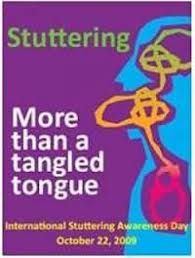Dr. Hudock’s TedTalk about the experience of stuttering.

What is Stuttering?
- Stuttering is an interruption in fluent speech.
- Although everyone has moments of dysfluency, people who stutter have more frequent speech disruptions.
- Stuttered speech includes frequent disruptions, such as repetitions or prolongations of sounds, words, or even phrases.
- Stuttering isn’t necessarily a problem, but it can make communication difficult for both the speaker and listener.

Who Stutters?
- Approximately 5% of children stutter for an extended period of time (more than six months).
- There is a 4:1 ratio of boys who stutter to girls who stutter. However, 75% of preschoolers who stutter stop.
- In adulthood, the ratio of men who stutter to women who stutter is 2:1.
- Currently, over 3 million Americans stutter, amounting to 1% of the population.
- Stuttering appears to have a family connection – people who have family members who stutter are more likely to stutter themselves.
Characteristics of Stuttering
- Repetitions: Repeating a single sound, partial word, complete word, or phrase
- Ex. W-w-w-what time is it?
- Prolongation: Stretching a sound out when unable to move to the next sound
- Ex. SSSSSSit down
- Interjections: Adding “um”, “uh”, or “like” in between words
- Ex. I um um want um a um cookie
- Blocks: A period of no airflow or voice, usually for several seconds
- Ex. Where did ___________ you park?
Things to Look For
- More than 2 repetitions of a sound, word, or phrase
- Stuttering that lasts for longer than 6 months
- Signs of tension and straining in the facial muscles
- Stuttering or dysfluencies more than 10% of the time
- Dysfluencies in most, if not all speaking situations
- Episodes of dysfluency with periods of fluency in between (weeks or months)

Facts about Stuttering
- People who stutter report that they stutter less in certain situations
- Choral speech
- Whispering
- Speaking to animals, infants, or yourself
- Speaking with an accent
- Acting
References
Bloodstein, O. (2007). A handbook of stuttering (6th ed.). Stamford, CT: Thomson Delmar Learning.
Buchel, C., & Sommer, M. (2004). What causes stuttering? Plos Biology, 2(2), 0159-0163. doi:10.1371/journal.pbio.0020046
FAQ. (n.d.). Retrieved from http://www.stutteringhelp.com/faq.
Stuttering. (n.d.). Retrieved from http://www.asha.org/public/speech/disorders/stuttering.htm.
Stuttering frequently-asked questions. (1996). Retrieved from http://www.mnsu.edu/comdis/kuster/Kehoe/FAQstuttering.html.
The Stuttering Foundation. (n.d.) If you think your child is stuttering [Brochure]. Guitar, B., & Conture, E.G.: Authors. Retrieved September 1, 2013 from http://www.stutteringhelp.org/sites/default/files/pictures/0041iyti.pdf
What is stuttering? (n.d.). Retrieved from http://www.westutter.org/what-is-stuttering/stuttering-info/.
Yairi, E., & Seery C. H. (2011). Stuttering foundations and clinical applications. Upper Saddle River, NJ: Pearson Education, Inc.